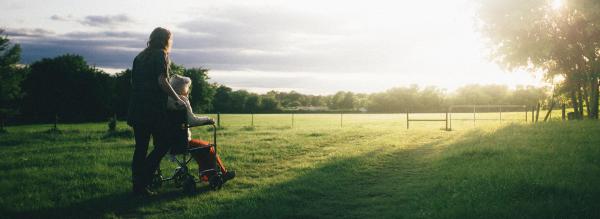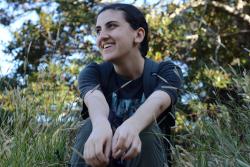
The subtle art of giving a damn – kick-starting the carer conversation at UTS
One in 10 Australians is a carer – taking time out from their own lives to look after a friend or family member. But getting the rest of us to sit up and take notice takes courage, say collaborators on a pioneering art project.

Leila Frijat, UTS Carer-in-Residence
Profile page
Making Meaning: Art as an Act of Care is a performance piece by Danica Knezevic. It’s also an online exhibition of photographs and video inspired by Danica’s own experience as a carer. But most importantly it’s a conversation starter, say the team involved in the innovative collaboration between UTS faculties.
Or, as Leila Frijat, UTS Carer-in-Residence, puts it, “A lot of caring is performed in intimate domestic spaces, what Danica did was bring it into the public. She made it visible.”
The potential of the work to spark discussion became obvious to project lead and researcher with the Centre for Carers Research at UTS, Paula Gleeson, quite rapidly.
“The online exhibition gave people a way to talk about the subtle things in the act of caring – not how do I navigate the NDIS or contact Carers NSW, but how my aunt helps my grandmother to preserve things that are important to her, those little things in terms of how she appears, her dignity.”
It’s this aspect of caring – the immense emotional reward, and the corresponding emotional toll – that is regularly lost when it’s described by medical professionals, public health academics or policy bureaucrats, according to Barbara Doran, artist and UTS creative practices lecturer.
“Artmaking can reveal qualities of care that traditional research can’t tap into.”

Live performance of ‘Making Meaning: Art as an Act of Care’ by Danica Knezevic. October 2020. Credit: Tim Alewood.
PUBLIC FACES INTIMATE SPACES
During Carers Week “How is caring for others meaningful to you?” was pasted across UTS’s front windows, snaring attention from drivers and foot-traffic alike. But it’s a question that prompted reflection on behalf of the project team as well.
“People sometimes think the physical aspects of care require the most energy and the most work. But it’s the emotional energy and the ability to hold that patience and kindness which I think is really hard,” says Leila, who cares for her younger brother outside of her work commitments at UTS.
There’s a misconception that caring must be completely frantic, but it’s in the quieter moments that I feel the most impact and the most meaning in care. It offers a space for reflection.
For many who perform caring roles, there is also a cumulative weight – both physical and emotional – in carrying out simple repetitive actions like removing someone’s shoes, stroking their hair, or carefully easing them down onto a hospital bed. All of which occurred as part of Danica’s performance in the UTS Building 2 foyer.
Executing these silent, intimate gestures in such a busy public space was designed to elicit a response, and it did, says Barbara.
“At some performances there were people standing there watching Danica and they’d just start crying. This is feeling as a way of understanding, watching, engaging with art, you’re thinking ‘I am moved’ even if you don’t have words for it.”
UNIVERSITIES ARE MORE THAN LECTURE HALLS AND ACADEMICS
The full title of the team’s project is Making Meaning: Art as Acts of Care. Behind it is a simple assumption, if something is meaningful, it will have an impact, explains Paula.
Or as Barbara, a practicing artist puts it, “Art invites people to make sense of it. To make their own meaning. It provides a space for navigating uncertainty. There are things that happen in the act of care that aren’t captured in the qualitative and quantitative research discussions about this. And it’s not just in research it’s in policy. It’s a blind spot in our broader cultural conversation.”
Collaborations between artists, academia and carers, from whatever walk of life, is something that universities have a unique opportunity to lead, according to Barbara.
“The invisibility of care and lack of cultural appreciation of what the arts do for us kind of have a shared root system in terms of our cultural values. So if we bring them together, not just as a one-off project but as part of a long-term sequence of work, we can build a really dynamic root system that changes the way people think about these things.”
The rewards of doing so are potentially immense, says Paula.
“Caring for others is a part of all of our lives, it is a part of the human experience, and connecting over our universal experience of caring elevates us all.”
“That’s what so amazing. I think the question of how is care meaningful to you is such an inclusive question. Everyone has experienced care in some form, whether they’ve provided it or received it,” says Leila.
Making Meaning: Art as Acts of Care was funded by the Centre for Social Justice & Inclusion through its Social Impact Grant scheme.
The Problem
Although carers make up around 10 per cent of the population, the work they do is not visible to the wider community.
The Response
Artist, Danica Knezevic, the Faculty of Transdisciplinary Innovation and the Centre for Carers Research came together to create Art as Acts of Care – a performance and online exhibition featuring photographs and video.
What helped accomplish this?
The collaborative cross-disciplinary nature of the project enabled the team to explore care in a holistic way. The Social Impact Grant from the Centre for Social Justice & Inclusion enabled the project to go ahead.
What has changed as a result?
Art as an Act of Care has progressed the conversation at UTS and in wider community about carers and their contribution – the team received coverage on 2SER and ABC Radio National.
Download full case study
